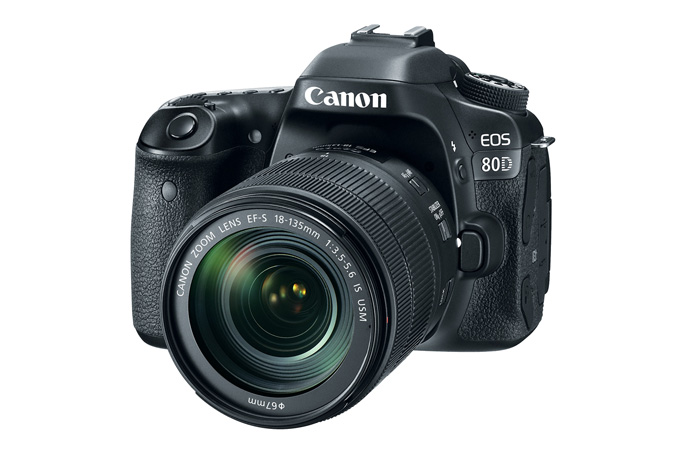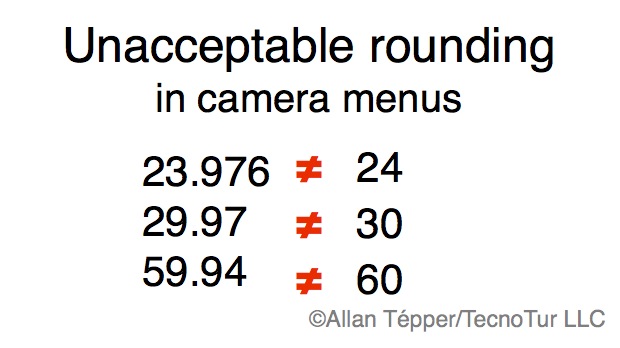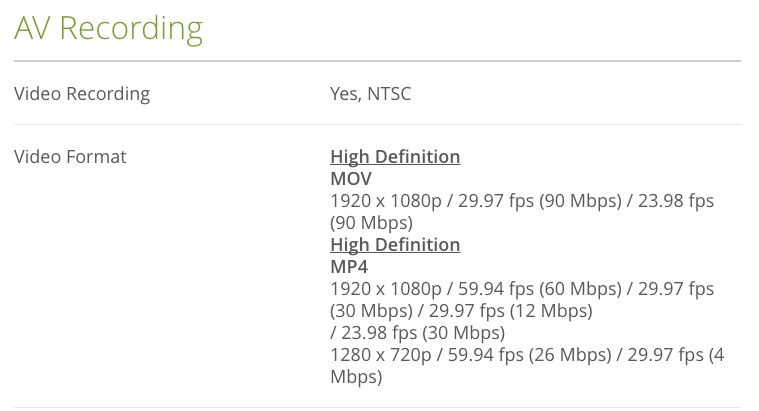
Canon has been justifiably criticized for the past few years for its lack of innovation in its low and mid range photo-style cameras’ video capabilities. However, with the EOS 80D, Canon has finally improved many audio/video functions, even though the company has unfortunately disguised some of them, as I’ll cover ahead. There will be applause about six positive details (some of which no one else is discussing), and eight criticisms.
Five details I applaud about the Canon EOS 80D for audio/video
1: The EOS 80D abandons the 30 fps myth

As I have explained in many prior articles, exact 30 frames per second has not been a video standard since before 1953, when the United States colorized the previous monochromatic system. Many camera, camcorder, and streamcorder manufacturers have been guilty of rounding non-integer framerates like 23.976, 29.97 and 59.94 to the closest integer in their menus, which has caused havoc among many users and even with some software developers, who have taken the numbers at face value, i.e literally. Fortunately, the Canon EOS 80D repents from that sin, and displays non-integer framerates in menus as 59.94, 29.97 and 23.98. As I have covered in prior articles, those numbers are not exact either, but they are close enough for our purposes. I wish Canon had written “23.98” as “23.976”, but I am glad to know that they are no longer incorrectly calling it “24” when it’s not 24.000.
2: No visible moiré in footage in the video I’ve seen
Unlike prior low and medium level cameras from Canon, I fortunately see no moiré in the footage I’ve seen from the Canon EOS 80D. Here is an example from The Camera Store of Calgary, Alberta, Canada:
https://youtu.be/ZqsCRadQuHk
The Camera Store does excellent reviews, although they don’t nitpick the non-integer framerate issues the way they should.
3: Worldcam in disguise, even in the US version
At first, I was upset because the Canon EOS 80D sold in the US appeared to be a segregated camera, and I thought I was going to recommend those interested to import the European model, which is properly documented as a worldcam on European websites. I was glad to find out that the version sold in the US is indeed worldcam. It’s just that the published specs are incomplete on websites like those from B&H Photo:

In fact, on the B&H website, there is even misinformation in the Q&A section about that topic, where users have asked if the Canon EOS 80D can record framerates derived from PAL (i.e. 25p and 50p), and a B&H employee has regurgitated the incomplete (and therefore inaccurate) specs, instead of delving deeper to find the truth, as you’ll see here:
Fortunately, despite the inaccurate information from the B&H employee, two people who purchased the Canon EOS 80D have chimed in below to correct the misinformation, as you’ll see above. Lower on the same Q&A page, a similar question was properly answered by someone who is not a B&H employee:
I chose the word misinformation carefully, because I really doubt that B&H would intentionally cause disinformation that has likely cost them sales, since the misinformation is underselling the product and dissuading people who must have 25p and 50p capabilities. I suspect that B&H initially copied and pasted incomplete information from Canon from when the EOS 80D was first announced, and then never updated the information.
This is not the first time I have seen this exact type of error. The B&H website continues to misinform about the worldcam capabilities of the JVC GY-HM170 and JVC GY-HM200 (covered in JVC GY-HM200 versus Sony PXW-X70: Let’s compare them carefully, JVC clarifies key details in the GY-HM170 camera/camcorder
and in Why we should only use worldcams illustrated above), both of which are completely worldcam in HD and 4K UHD modes, and are only segregated in standard definition. I have this in writing directly from the JVC product manager of these two models, from the user’s manual, and from a local friend who recently purchased the GY-HM200.
I downloaded the user manual of the US version of the EOS 80D, which also confirms that the camera is indeed worldcam, but lacks the information about exactly which shutter speeds are available at each framerate. So I visited Pitman Photo Supply here in Miami and was very well attended by Selenne A. Mayoral-Cruz. Selenne is completely bilingual and is very familiar with the Canon menu system, and was very happy to assist me in checking the available shutter speeds at each framerate, as you’ll see in the next section of this article.
4: Fairly generous shutter speed options for video, with one exception.
1080/25p
- 1/4000
- 1/3200
- 1/2500
- 1/2000
- 1/1600
- 1/1250
- 1/1000
- 1/800
- 1/640
- 1/500
- 1/400
- 1/320
- 1/250
- 1/200
- 1/160
- 1/125
- 1/100
- 1/80
- 1/60
- 1/50
- 1/40
- 1/30
- 1/25
1080/29.97p and 1080/23.976p
The available shutter speeds are the same at 1080/29.97p and 1080/23.976p (rounded to 23.98p in the EOS 80D menu)
- 1/4000
- 1/3200
- 1/2500
- 1/2000
- 1/1600
- 1/1250
- 1/1000
- 1/800
- 1/640
- 1/500
- 1/400
- 1/320
- 1/250
- 1/200
- 1/160
- 1/125
- 1/100
- 1/80
- 1/60
- 1/50
- 1/40
- 1/30
As you have seen, the available shutter speeds at 25p are nearly identical to those available at 23.976p and 29.97p. Only 1/25 is logically missing at 29.97p and 23.976p. Presumably to save space, only the denominator of the fraction that represents each shutter speed is displayed on the EOS 80D screen. At this point, I must clarify that the shutter speeds are likely rounded to the closest integer. This is something I covered in my 2012 Why I pardon rounding of shutter speeds in camera menus, but not framerates!.
I am happy to see that Canon was generous in offering nearly all of the same shutter speeds even when switching between derived-NTSC and derived-PAL framerates. This can be helpful when you are shooting a derived PAL framerate like 25p in a 60 Hz country, it is good to have all of the framerates that match derived-NTSC framerates available if you notice a flicker caused by the 60 Hz lighting. In other words, you could choose 1/60. Likewise, if you are shooting in a derived-NTSC framerate like 23.976p or 29.97p in a 50 Hz country, it is good to have all of the framerates that match derived-PAL framerates available if you notice a flicker caused by the 50 Hz lighting. In other words, you could choose 1/50.
C’mon Canon! Where’s the 1/48 shutter speed?
The 1/48 shutter speed is notably missing from the list of shutter speeds Selenne and I found at any of the tested framerates. If it were available, the 1/48 (i.e. 1/47.952) shutter speed would be the exact one to choose to have exactly 180 degree shutter when shooting at 23.976p. Some people say that using 1/50 is “close enough”, but what would it have cost Canon to include 1/48 too? If you are shooting at 25p, then the exact 180 degree shutter is achieved at the 1/50 shutter speed. If you are shooting at 29.97p, the exact 180 degree shutter is achieved at 1/60.
5: Great autofocus and follow focus for video
In the review shown above from The Camera Store, you can see these two in action.
6: Headphone output
I believe this is the first time Canon has included a headphone jack for audio monitoring at this price level photographic-style camera.
Eight EOS 80D details that are currently imperfect for video producers
- Single card slot (Most other cameras in this range offer two.)
- Currently limited to 29:59 per video clip (Probably due to import tariff classifications in some regions.)
- Currently, splits video files into ±4GB chunks, even when using SDXC formatted as exFAT. (Other cameras have fixed this.)
- It (currently) offers no 4K UHD, as many other cameras do, at all price ranges.
- No waveform monitor, zebra stripes
- No RAW video
- No clean HDMI for use with an external recorder
- Lack of 1/48 shutter speed, as covered above
All but the first item on the list could potentially be fixed by a Canon firmware update… or by a third-party hack.
Extra reading
I recommend the article Canon 80d, the camera you wanted 3 years ago by DSLR Film Noob.
Upcoming articles, reviews, radio shows, books and seminars/webinars
Stand by for upcoming articles, reviews, and books. Sign up to my free mailing list by clicking here.
Si deseas suscribirte a mi lista en castellano, visita aquí. Si prefieres, puedes suscribirte a ambas listas (castellano e inglés).
Listen to his CapicúaFM show at CapicúaFM.com in iTunes or Stitcher.
FTC disclosure
No manufacturer is specifically paying Allan Tépper or TecnoTur LLC to write this article or the mentioned books. Some of the other manufacturers listed above have contracted Tépper and/or TecnoTur LLC to carry out consulting and/or translations/localizations/transcreations. Many of the manufacturers listed above have sent Allan Tépper review units. So far, none of the manufacturers listed above is/are sponsors of the TecnoTur programs, although they are welcome to do so, and some are, may be (or may have been) sponsors of ProVideo Coalition magazine. Some links to third parties listed in this article and/or on this web page may indirectly benefit TecnoTur LLC via affiliate programs.
Copyright and use of this article
The articles contained in the TecnoTur channel in ProVideo Coalition magazine are copyright Allan Tépper/TecnoTur LLC, except where otherwise attributed. Unauthorized use is prohibited without prior approval, except for short quotes which link back to this page, which are encouraged!

